

It isn't initially my intention to cover every Squier Stratocaster made in Korea, this page will be some general info and
guitars I think are interesting but may develop further in due course. The definitive website for all things Squier is
Squier Wiki
Some General information about woods serial numbers and logos
I have posted this information many times on the Strat forum and one of the reasons for starting this section of my website
was to have this readily available, although it is available in various forms elsewhere.
| Logo etc | Details |
| Black Logo | Made roughly 1992 to 1995 always thin plywood body and poor quality, CN and VN etc |
| Silver Logos | Unless Fender Branded with Small black Squier series these are 80s Guitars. But see below E9 |
| Silver Logo E7 or E10 serial numbers | Good quality Young Chang Guitars Alder bodies with Maple top and back |
| Silver logo E9 S9 or S10 serial numbers | Full width ply bodies see E9 debate below |
| Silver Logo Squier II E9 S9 M1 or J1 logos | Thin Plywood body |
| Gold Logos | 1995 onwards various serial numbers all full width Alder Bodies except the Protone which is full width Ash |

The E7 and E10 were both made in 1987, some sources suggest the E10 is later but that's wrong.
There were 2 models a 57 and a 62 and they were direct replacements for the Japanese models like the ST362 and 357. As
always with far Eastern models these are not reissues just similar to 57 and 62 models.
Good quality guitars built by Young Chang. I don't think that there is any difference between those with an E7 serial
number and those with an E10 except that the E10s were earlier the first Korean Squiers.
The serial numbers on these have a real tendency to fade to invisibility so if you can't easily see the serial number
don't be unduly worried.
| Model | 57 | 62 |
| Body | Alder with Maple Top and Back | Alder with Maple Top and Back |
| Neck | Maple soft V | Maple C shape |
| Fretboard | Maple 21 Frets 9.5" radius | Rosewood 21 Frets 9.5" radius |
| Tuners | Chrome Fender Branded Diecast Gotoh | Chrome Fender Branded Diecast Gotoh |
| Headstock | Small with silver logo see pictures | Small with silver logo see pictures |
| Pickups | Ceramic | Ceramic |
| Controls | Standard Strat White Plastic | Standard Strat White Plastic |
| Nut | 42mms | 42mms |
| Hardware | Chrome | Chrome |
| Pickguard | 8 hole single ply white | 11 hole 3 ply white |
| Colours | Arctic White, Black, Torino Red or Lake Placid Blue | Arctic White, Black, Torino Red or Lake Placid Blue |
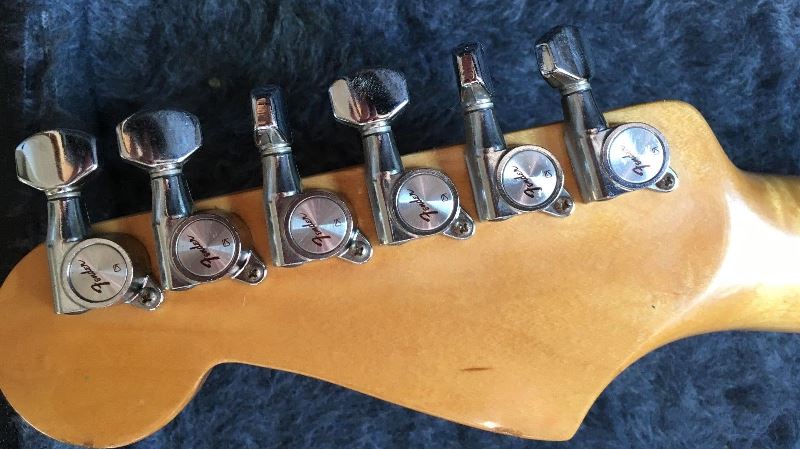

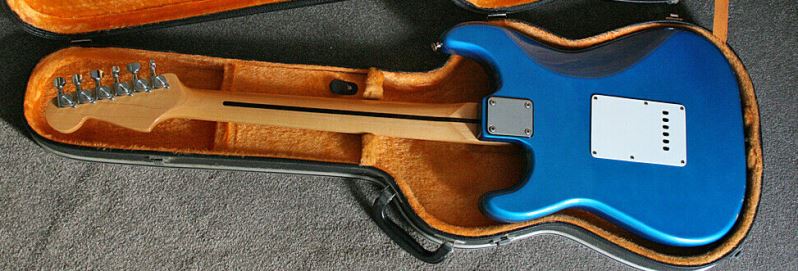
Update Oct 2025
There is an inconsistency pointed out by stratmanshow of various Fender forums. The 12th fret dots have two distinct sets of spacing
some narrow Japanese style and some are wide in typical Korean style see pictures below. Also some guitars in the Squier and Fender range
have Gotoh branded tuners and some Fender Branded Tuners. We used the forums to gather as much info as possible and found some Fenders and Squier
E10s and E7s had the narrow spacing. The Squiers had the narrow spacing quite rarely the Fenders slightly more often. There did not appear to be
any co-ordination with the serial numbers except they seemed to be middle range numbers that had the narrow spacing and what appeared to be later
and earlier serial numbers with the wide.
The tuners all the Fender branded models had Gotoh branded tuners and Squier models mainly had Fender branded tuners with just the
odd one having Gotoh branded ones.


Following a post on Strat talk it would appear that there are some E9 serial number guitars with Silver logos
and solid bodies my inclination was that these are made by Young Chang but there is good reason to suspect that
this isn't the case.
Meopz from the forum posted his guitar which is a solid body E9 silver logo headstock picture below.
Chukkernation from the forum also owns one and has posted pictures and posted pictures of an advert for another one.
Two of them seem to be an all Maple neck and board and one has a Rosewood board so like the E7 and E10 there
appears to be a 57 and a 62. Some E9s have trap tuners and some have diecast tuners whether the body is solid or not
doesn't affect which tuners they have.
The problem with them being Young Chang is that the routing looks completely different to the E7 and E10s and in
fact looks quite like the Protone routing suggesting Cort.
Trying to get some pictures of routing on the 89 90 Laminate guitars from anyone to compare.
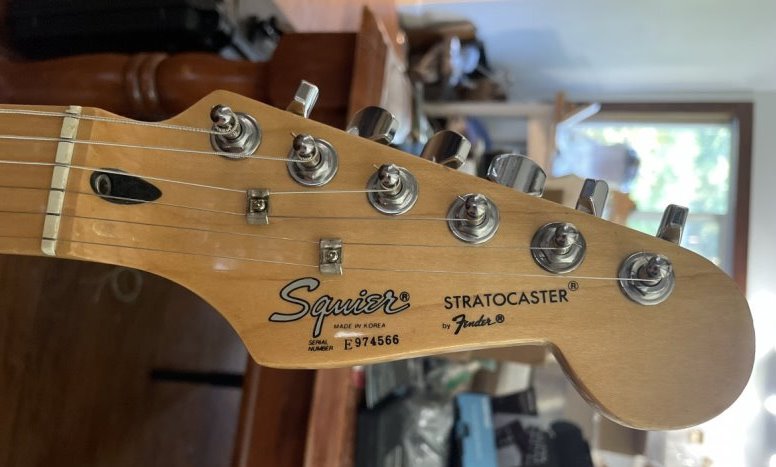
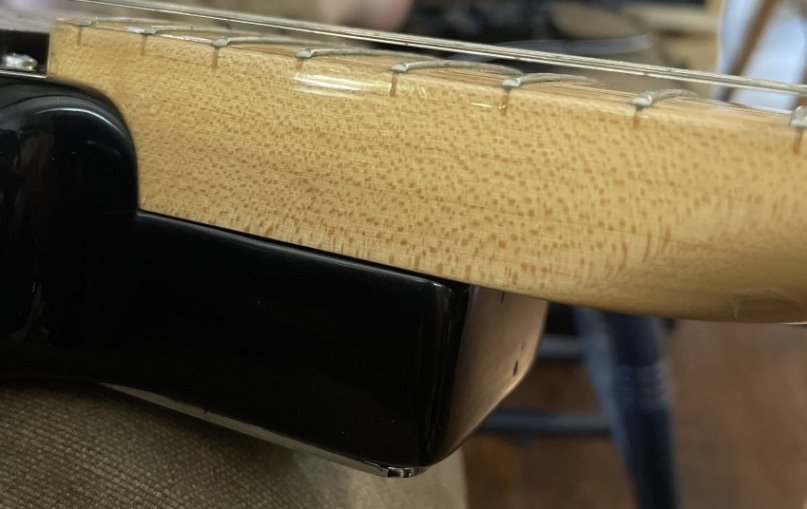
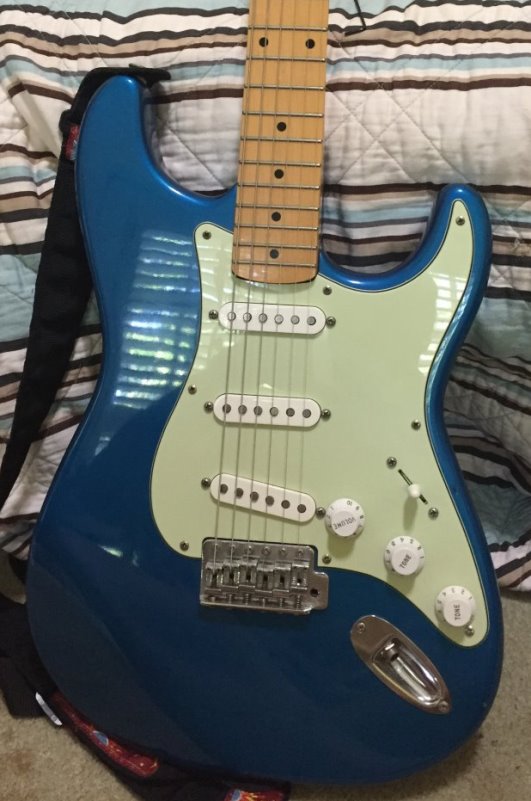
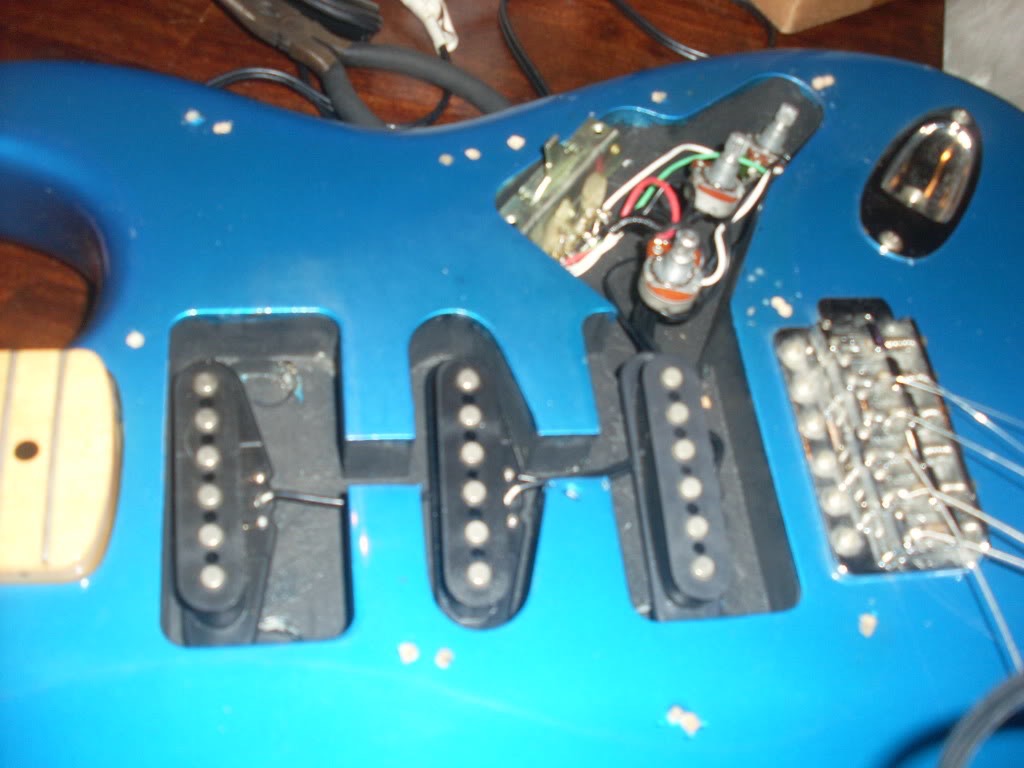

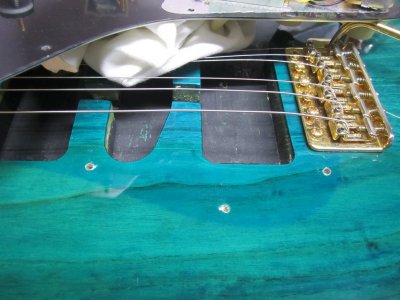
1st September 2023 The plot thickens
We have two more pictures of the routing of E9s One is a Squier II kindly supplied by jmdean of the Squier forum and the other
a standard laminate E9 Squier supplied by stratmanshow the first is a similar style to the E10 but not the same and the second doesn't
look like anything else in this series. So either there are several manufacturers for E9s or the same manufacturer is routing them differently.
Further investigation begins to shine some light on this. I am now certain that some E9s were made by Young Chang this is verified
by the presence of the Kenji sticker, which only Young Chang used. These are recognisable by the serial number script which is in
a silvery grey colour. Those with the black serial number will be another manufacturer. These are either Cort or Samick routing is
so similar to Cort it must be Cort. See pictures below.
So in conclusion
E9 silver grey serial number Young Chang
E9 Solid body black serial number Cort
E9 Laminate probably Samick routing is similar to Samick
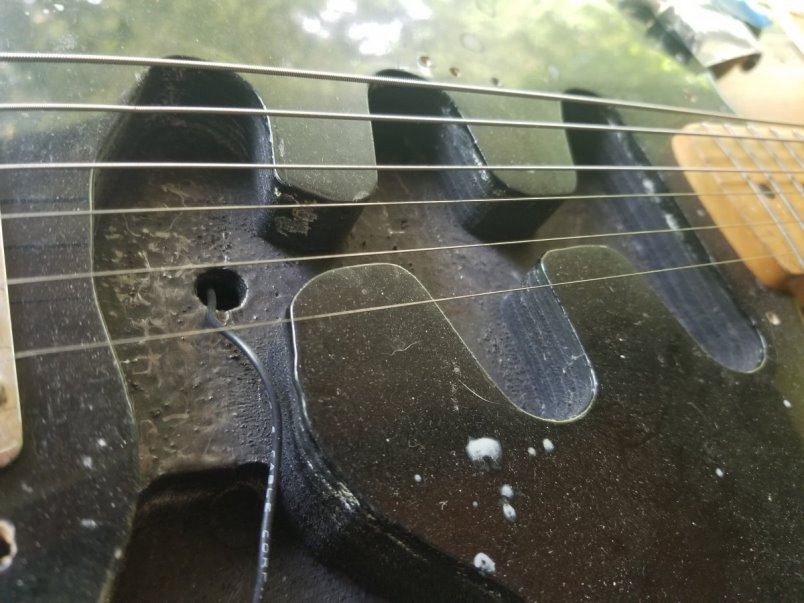
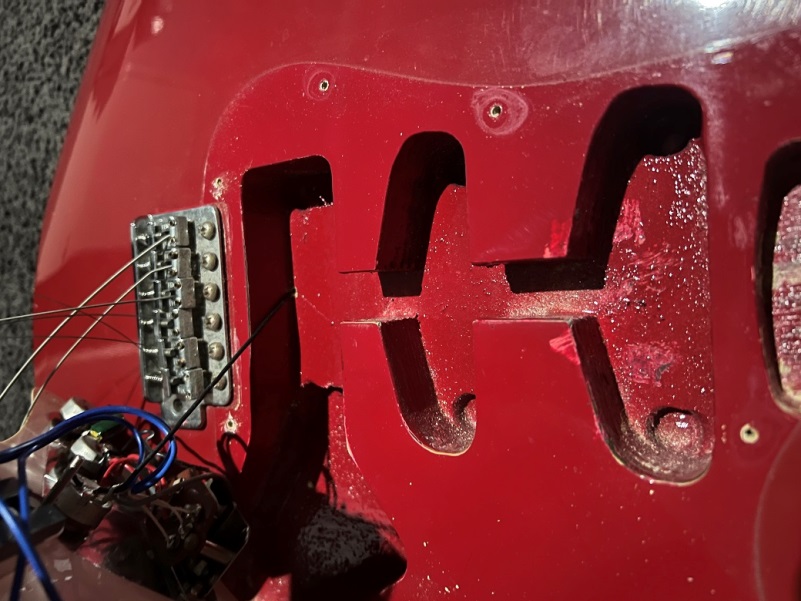
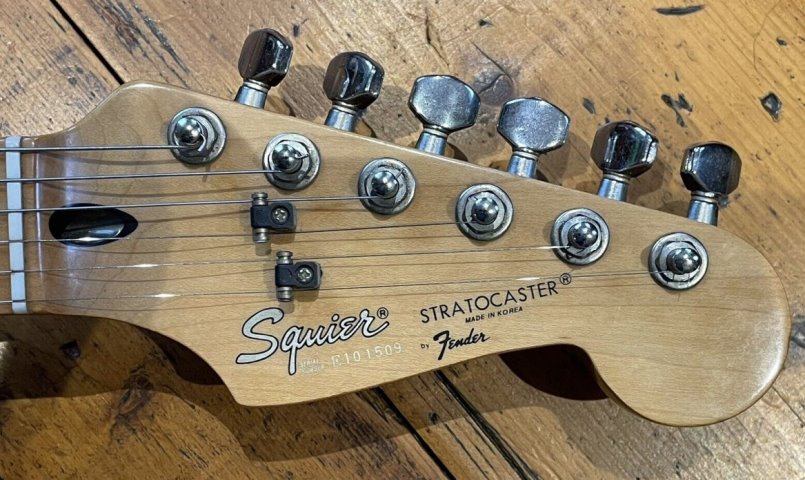

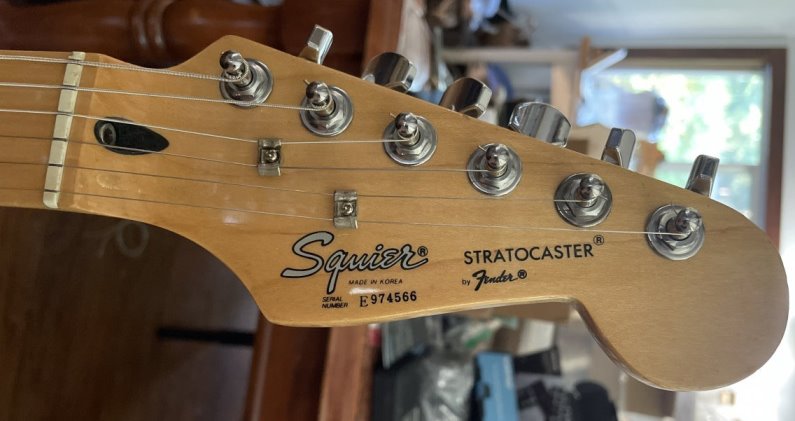



Most people will know the story of the Pro tones but just briefly in the mid 90s Joe Carducci became Squier Marketing manager
he felt that Squier needed to up it's game as it was losing market share to the many competitors. He decided that the way forward
was much better quality options. The Pro tones were born in 1996 well appointed great quality guitars and very good looking.
There was an SSS in several colours and finishes (5 in all) and a black HSS fat strat said to be the first time Fender had used the
term fat to describe a humbucker. As we all now know these were withdrawn in 1998 because they
were too good and sales of Fender branded guitars dropped off because of people buying pro tones.
These guitars were made at the Cort factory.
| SSS | HSS | |
| Body | Solid Ash | Solid Ash |
| Neck | 1 piece maple | 1 piece maple |
| Fretboard | 21 Frets 9.5" radius Maple or Rosewood dependant on colour | 22 Frets 12" radius Maple |
| Headstock | Plain (matching on the Oly White) see pictures | Black See pictures |
| Tuners | Diecast Gold on the CRT and SBT colour chrome otherwise | Gold Diecast |
| Hardware | Gold on the CRT and SBT colour Chrome otherwise | Gold |
| Pickups | 3 Alnico Single Coils white or aged covers | 2 Alnico Single coils 1 HB black covers |
| Bridge | Vintage style 6 pivot trem | Floyd Rose licensed double locking |
| Controls | Standard Strat White or aged | 1 volume 1 tone 5 way switch Gold Knurled |
| Pickguard | White shell except as below | Black Shell |
| Colours | Crimson Red Trans, Sapphire Blue Trans, Vintage Blonde with Aged Pickguard, 3 colour sunburst or Oly White with red shell pickguard | Black |
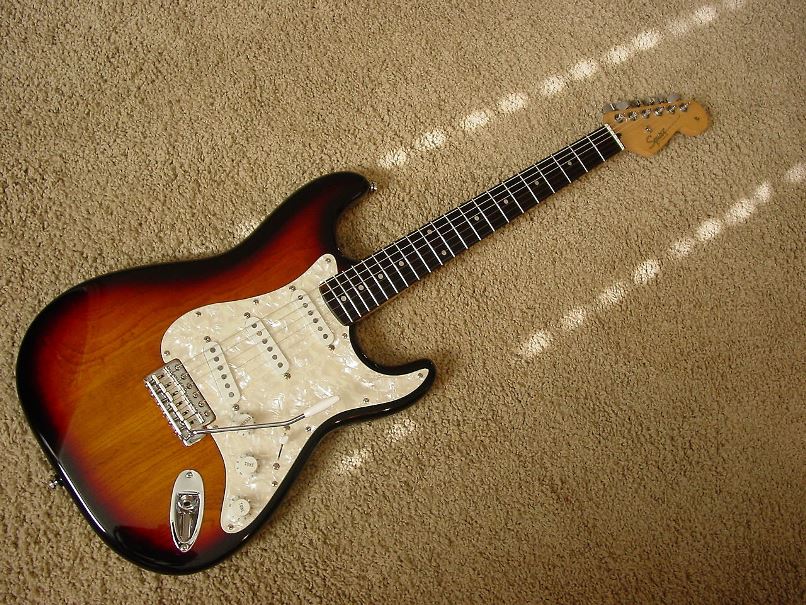
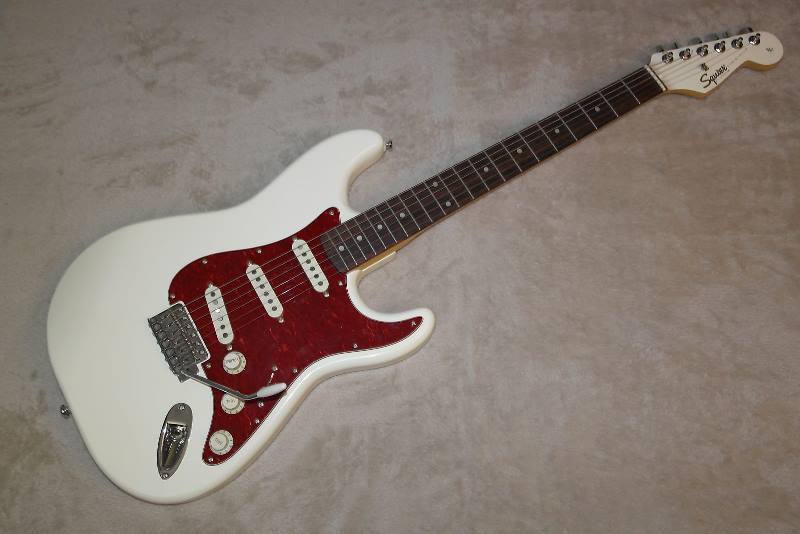

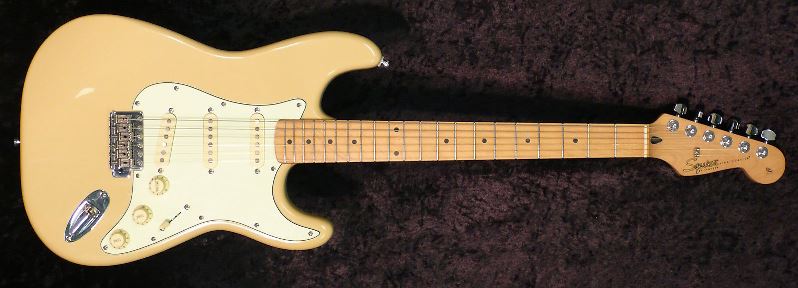

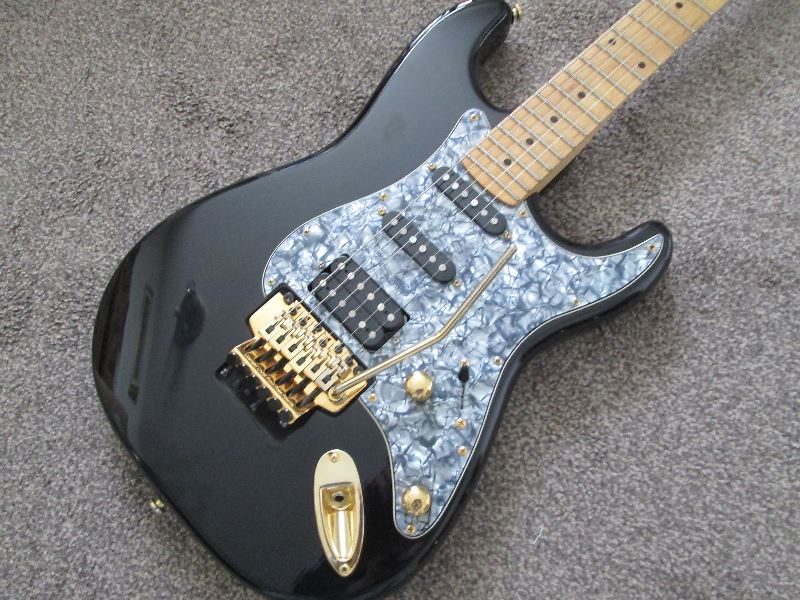

Around mid 1995 Korean Strats ceased to be made of Ply or laminate cheaper materials and reverted to solid Alder full sized bodies.
Easily identified by the change from Black to Gold Logo.
These were initially made by two factories Cort and Saehan, Saehan is also known as Sungham. Those with serial numbers CN and KC
are made by Cort and those with KV or VN serial numbers by Saehan. There are published specs for the CN models but it appears that
there are not universal to all models made then I am unsure of exactly why and what but here is what I know so far, this will be a work in
progress and I will add what I find out as we go along.
Specs Cort CN serial numbers
Body Full width Alder Poly finish
Neck Maple 4 bolt
Board Maple or Rosewood (LH Rosewood only) 9.5" radius 21 Frets very wide 12th Fret markers
Headstock TRA at Head Black Plastic plug Gold Logo Serial Number on Front with Made in Korea 2 wing type string trees
Tuners Hexagonal also known as "Trap" tuners much derided
Pickups Ceramics SSS
Hardware Chrome
Bridge 6 Pivot Sync Trem
Pickguard 3 Ply white 11 Hole
Colours Black, Midnight Blue, Midnight Wine, Arctic White or Sunburst
This is known in the 1996 catalogue as the Standard Stratocaster sometimes known as Standard Stratocaster V4
There is also a HSS model with the same specs except for the pickup configuration and according to the catalogue
available only in Midnight Blue and Midnight Wine.
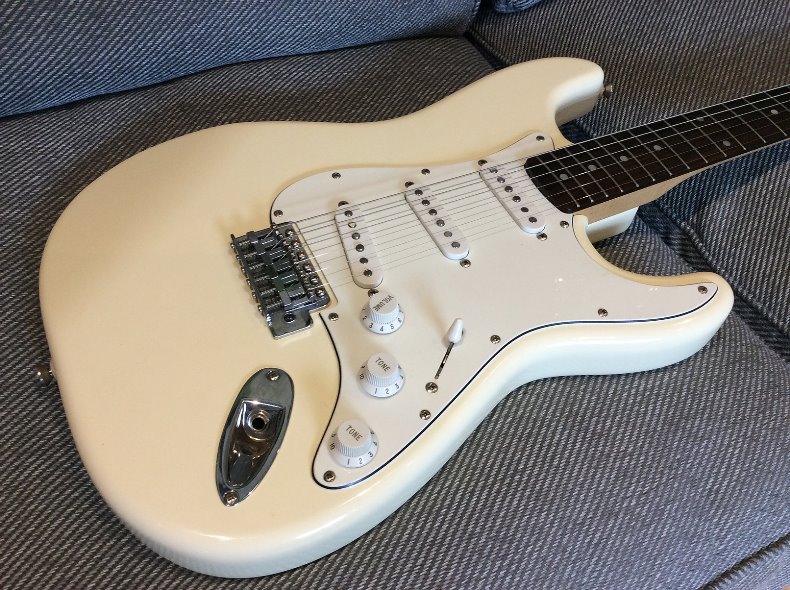
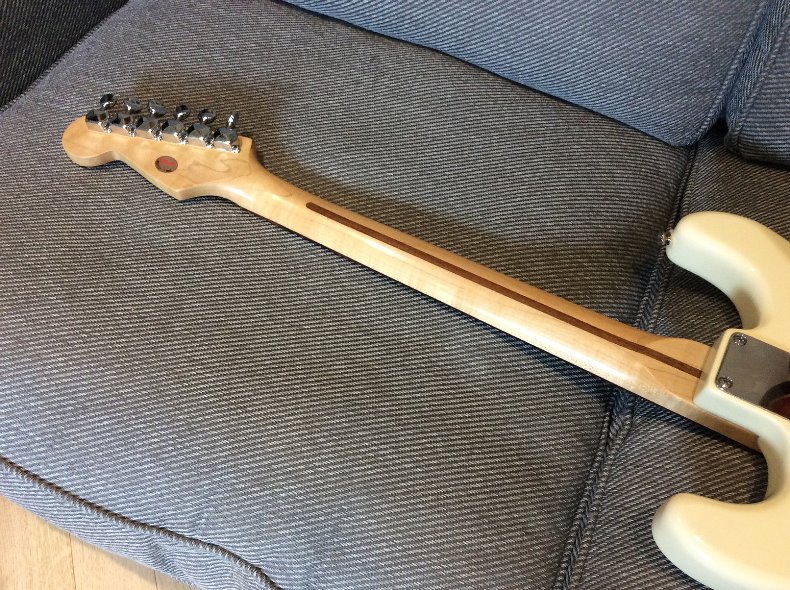
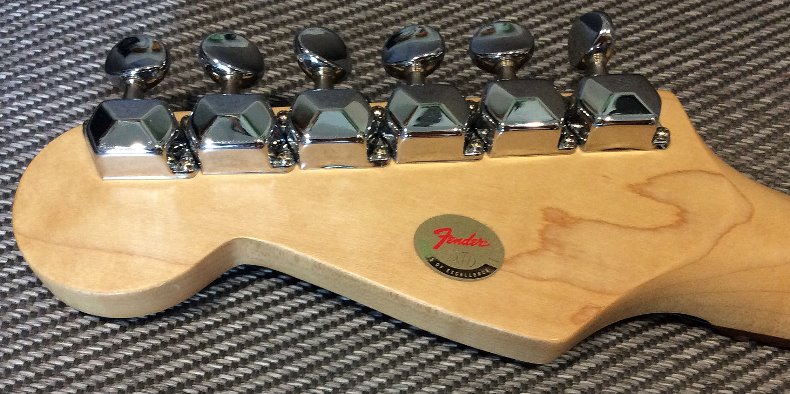
KV Models
I think this is the second generation of Squier Standards of this period. Probably replacing the Cort ones who have now moved on to Protones.
These are made by the Saehan factory with similar specs to the CN models except that I have seen enough of them
with Sealed diecast tuners to believe that these came as standard on some guitars, but I have also seen some with the "trap"
tuners. The headstocks are different as the serial number and "crafted in Korea" is on the base of the neck.
There appears to be no skunk stripe.


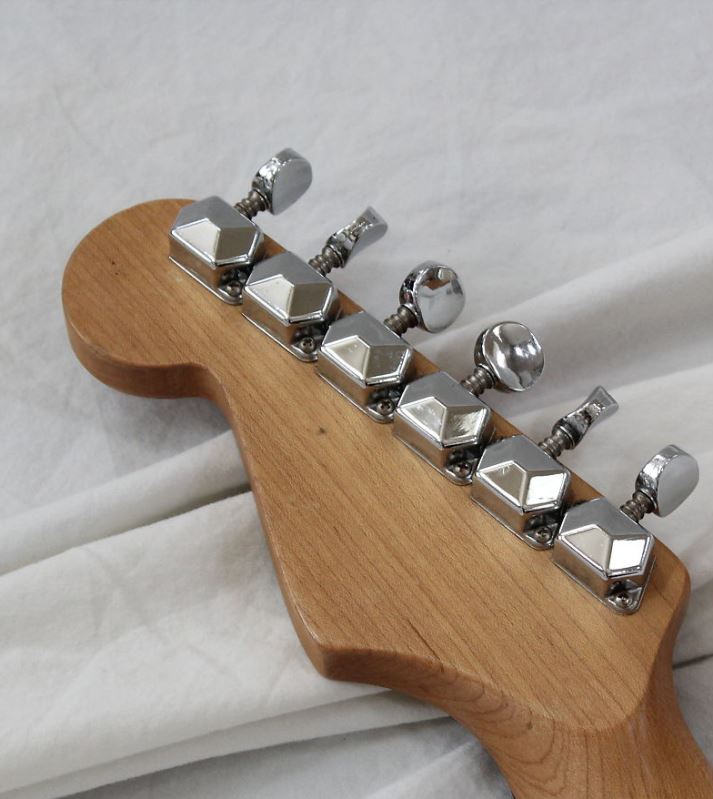
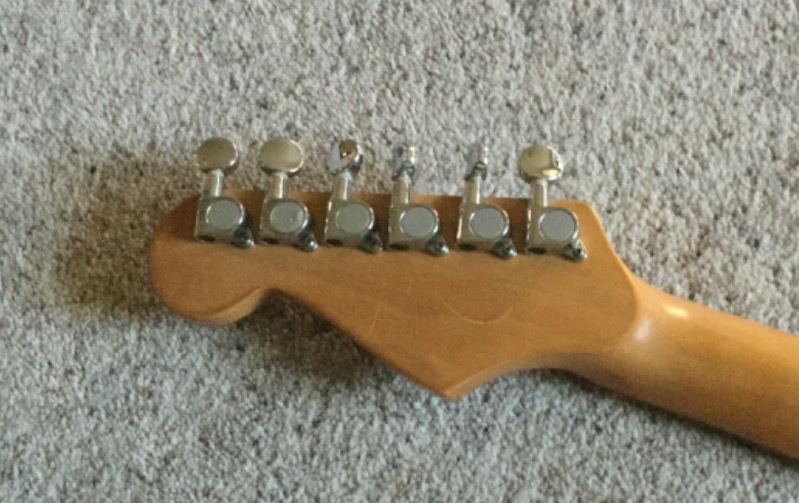

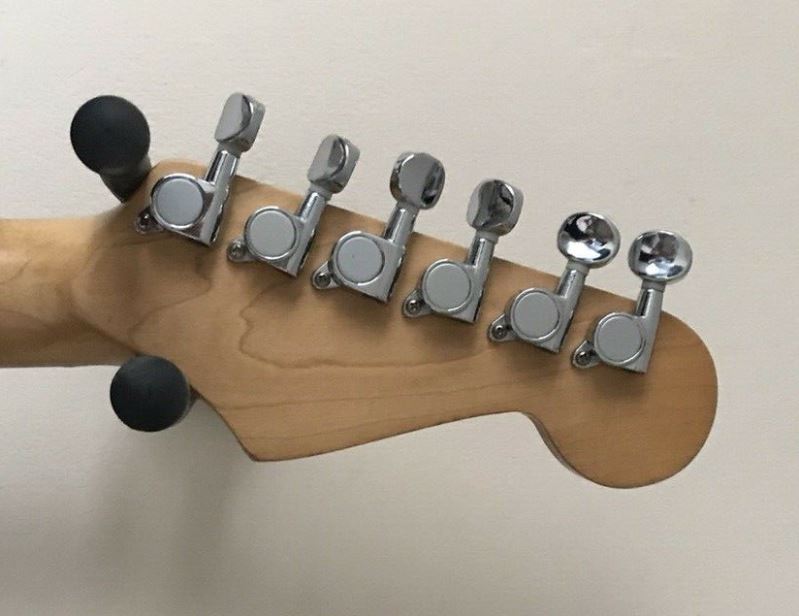
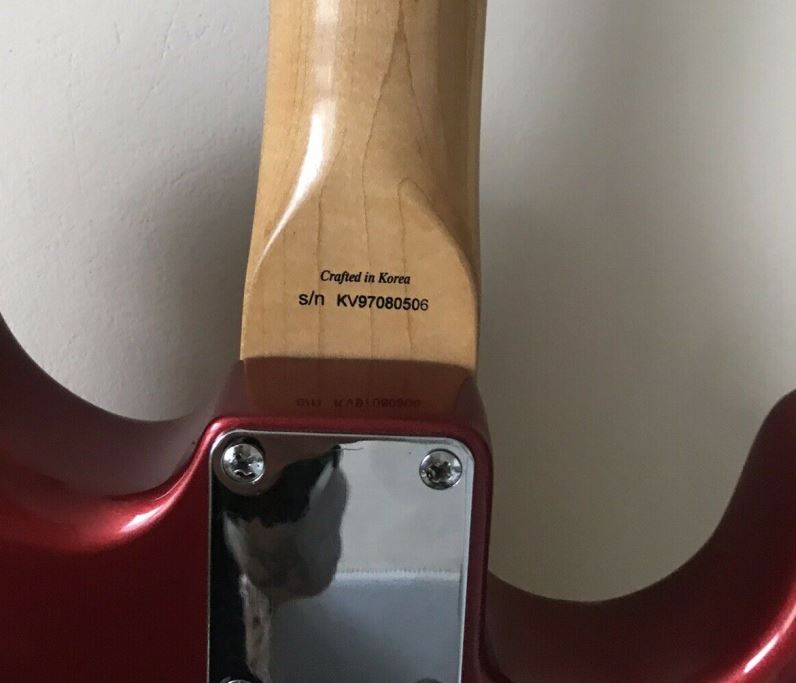

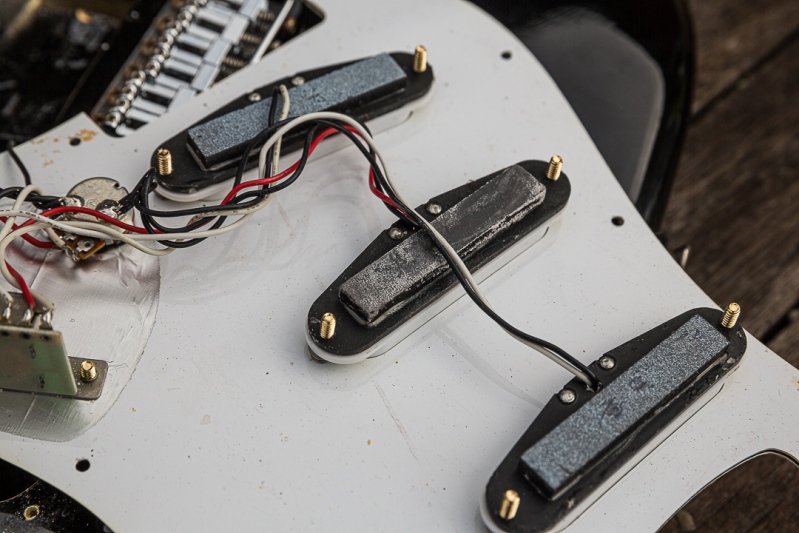
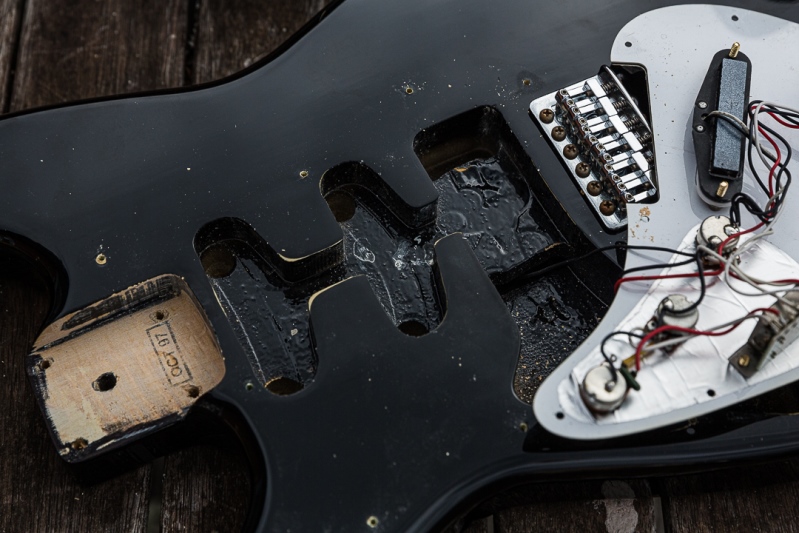
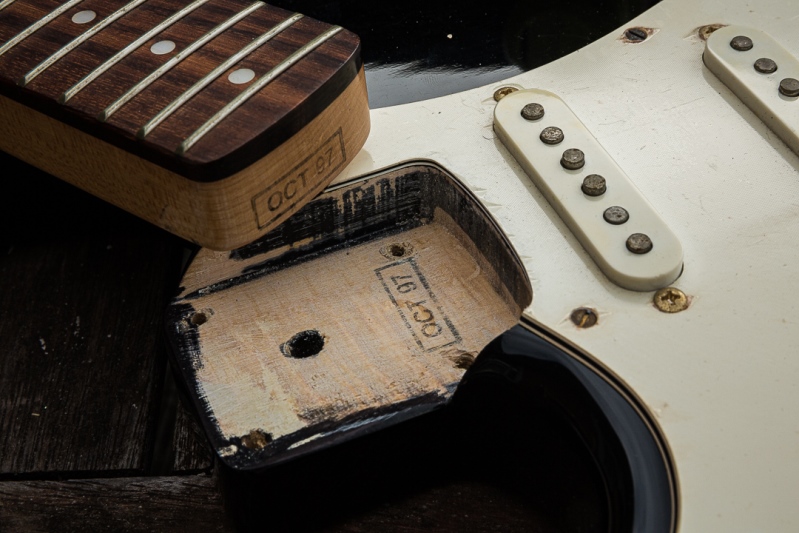
The VN Models
Obviously the VN indicates Saehan again but they differ from the KV but appear to have been made at the same time or perhaps
are just the last of a previous series. These have headstocks very like the CN models but I have only seen a couple and they do
not have the "trap" tuners but sealed diecast type. I can't find much more information on these

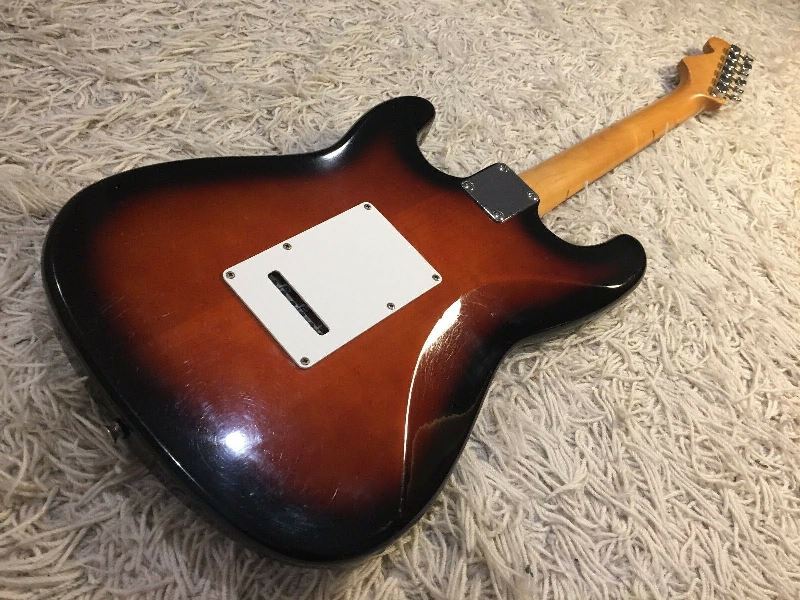
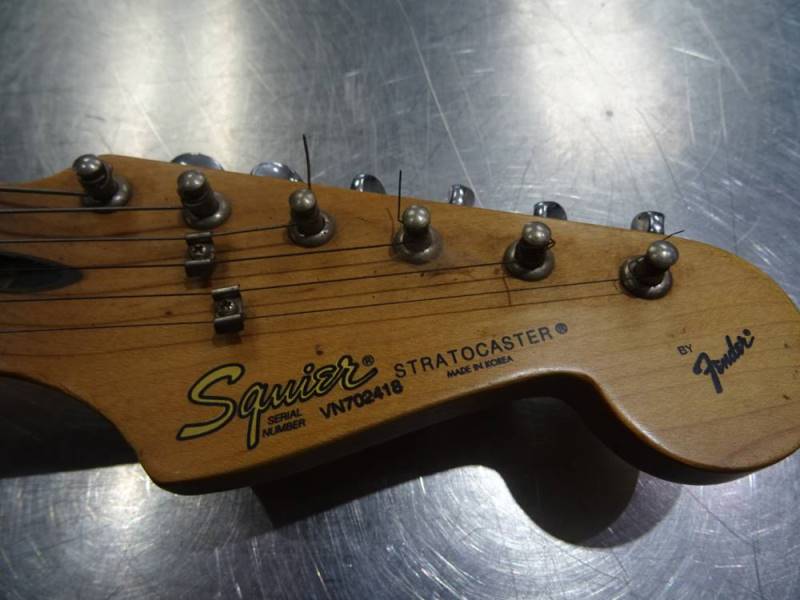
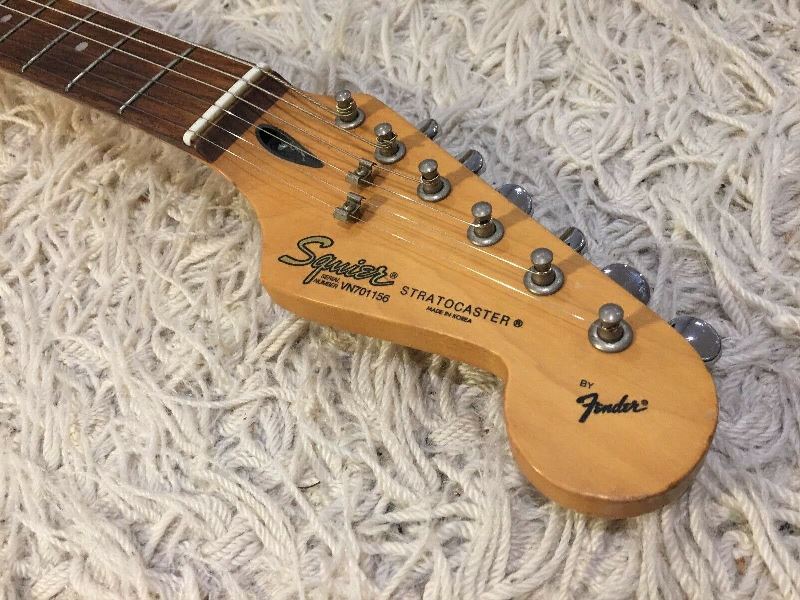
KC serial numbers
These were in use during this period notably on the Protone range and some other models. I have not been able to find
any standard strats using this range.
Update Jan 2021
The most knowledgeable person I know on Squier guitars and particularly on Korean models is a Squier talk member called Roccobagadonuts
he has clarified some of the above here are his comments
As far as the tuners go on the KV models the very first units built still came with trap tuners like the VN models they had been
making before the KV stuff. So you will see some KV97 models with traps and some with gotoh style tuners. Then pretty much all the
KV98 models will have gotoh style tuners. The KV models are pretty much the VN models except they changed the headstock logo and
moved serial number to back of neck. Then they eventually changed over to the gotoh style tuners instead of the traps. Beyond that the
only difference is colours as they moved from the midnight wine and midnight blue colours to Lake Placid Blue and Candy Apple Red.
Beyond that I noticed ya mentioned E7/E10 models as having Fender branded Gotoh tuners. Some also had just Gotoh stamped as well.
So you find both types of stamp on those models...
March 2023
Alex has written to me with some comments about the VN and CN models here are his thoughts:
I’ve played many strats in my time, but these MIK Gold Logos seem to have the most comfortable (satin) necks I’ve ever played.
I stumbled across a VN6 Gold Logo Strat 10 years ago for £70 (UK). I had no idea what it was (at the time) but the neck was a delight
to play. I’ve changed the tuners, electronics and body since, but the neck has stayed. Recently, I found an olympic/vintage white CN6
Gold Logo Strat for £150. Again, a beautiful guitar, BUT the necks are different. The VN6 is a bit more U shaped and the frets seem
to be in between vintage tall and medium jumbo. The CN6 has a slightly slimmer but more comfortable neck with vintage tall frets.
I believe both have a 9.5” radius. The differences are subtle but after 10years with the VN6, it’s easy to notice. Both bodies are
full width and take an import full block tremolo with ease. Before I changed the VN6 body, I sanded it down. It appears to be a
3 piece body
Thanks Alex I suppose it isn't surprising to find that necks from different factories have slight differences.